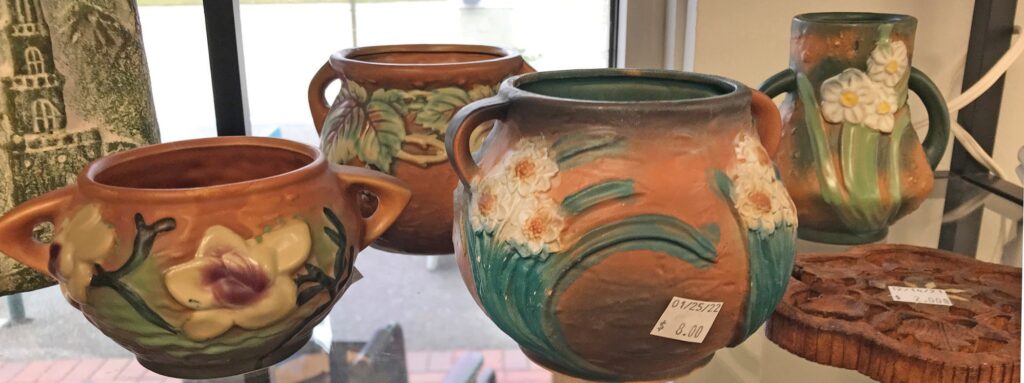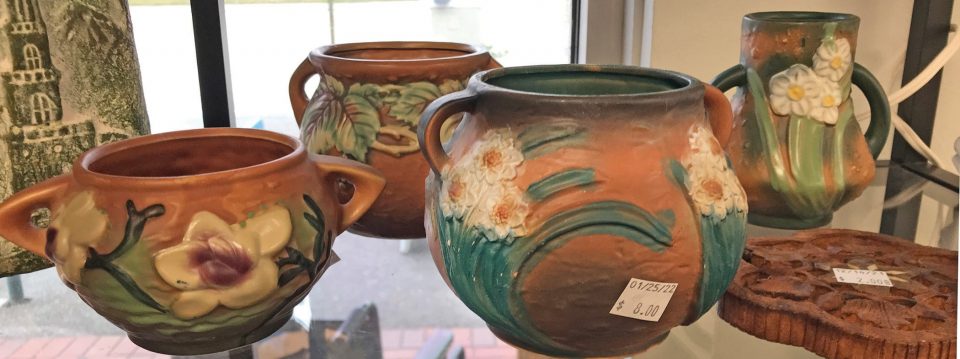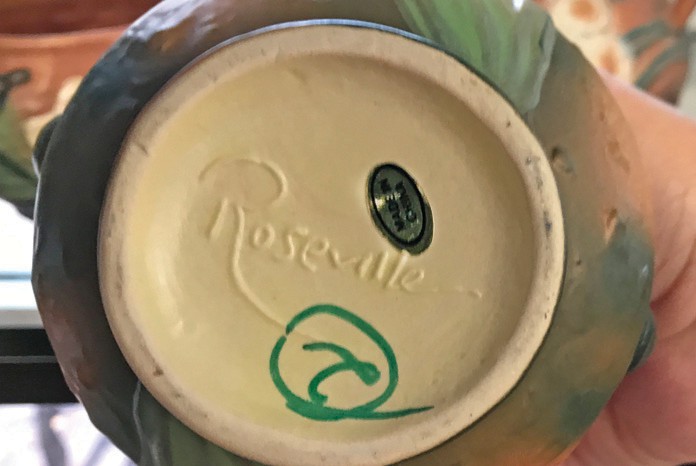
ABOVE: Reproductions of Roseville Pottery in the Magnolia and Jonquil patterns (front). SCOTT SIMMONS / FLORIDA WEEKLY
“Imitation is the sincerest form of flattery that mediocrity can pay to greatness.”
So said Oscar Wilde.
It can be said of so many of the reproductions we see out there — giclee prints of fine paintings, reproductions of classic furnishings and this grouping of Roseville Pottery pots.
A reproduction can honor a tradition or a style — Chinese artists often replicated earlier styles to honor them.
It’s the same with some of the so-called “century” pieces of Chippendale, Hepplewhite- and Sheraton-style furnishings made at the turn of the 20th century — they were fabulous quality pieces that paid tribute to earlier works.
Those makers often put their marks on the pieces — you knew you weren’t buying a piece that had passed through the workshop of Thomas Chippendale, but you were acquiring something worthy of display and built to last.
But not all reproductions are equal — and not all pay tribute to their origins.
That brings me back to the Roseville.
Roseville Pottery was the great midlevel American art pottery of the early to mid-20th century — just about everybody knew someone who had a piece in one of the Zanesville, Ohio, company’s floral patterns. These were wares you might expect to buy in a nice gift shop or department store for a few dollars — pricey in a day in which minimum wage was around 40 cents an hour.
The pottery became popular with collectors in the 1970s and continued to gain value until about 20 years ago.
That coincided with a general decline in the market for collectibles and a glut of reproductions made in Asia.
Made in the 1990s in China for A.A. Importing, a wholesaler of reproductions based in St. Louis, and marketed as “Roseville-style,” the grouping I spied in a thrift shop had all the earmarks of a reproduction — sprayed decoration, so you could see a faint outline of the mist of the spray at the edges of the pattern, uneven glazing on the interiors, oversaturated coloring and a matte glaze that has none of the sheen of original pieces.
In other words, they don’t look right.
But the variations might not be obvious to novice collectors, especially when the newer pieces are marked Roseville.
The pieces I spotted in the thrift store bore foil labels that read “Made in China,” which confirmed my suspicions. Also obvious: The Roseville marking lacked the “U.S.A.,” which was on many originals. That marking often is faint or nonexistent on the reproductions, says Real or Repro (www.realorrepro.com), an online reference.
The folks making the reproductions often put the Roseville mark on pieces that originally were unmarked, other than paper or foil labels — like the earlier Jonquil and Luffa patterns. Quality often varies, too, Real or Repro reports. But I’ve rarely seen a reproduction that wasn’t an obvious imitation.
There’s nothing wrong with buying a reproduction, as long as you know what you’re buying. Some dealers don’t know the difference — or do know and don’t care. It’s when something is misrepresented as authentic that it becomes problematic — particularly if you pay a high price thinking you’re buying the real thing. That’s why it’s important to educate yourself before buying.
The pots and vases I saw in the thrift store were priced at about $8 apiece — in line with what you’d expect to pay for a decorative painted pot. Similar vintage pieces might be priced in the $50 range.
As for me, I’d rather save my money for the real thing.
Don’t forget!
Vintage American Glass and Pottery Show and Sale — You can see the real thing at the South Florida Depression Glass Club’s show, worth a drive from anywhere, 10 a.m.-5 p.m. Feb. 5 and 10 a.m.-4 p.m. Feb. 6, Emma Lou Olson Civic Center, 1801 NE Sixth St., Pompano Beach. Tickets: $7; early buyer (9-10 a.m. Feb. 5), $12. Info, discount coupon: www.sfdgc.com. ¦




